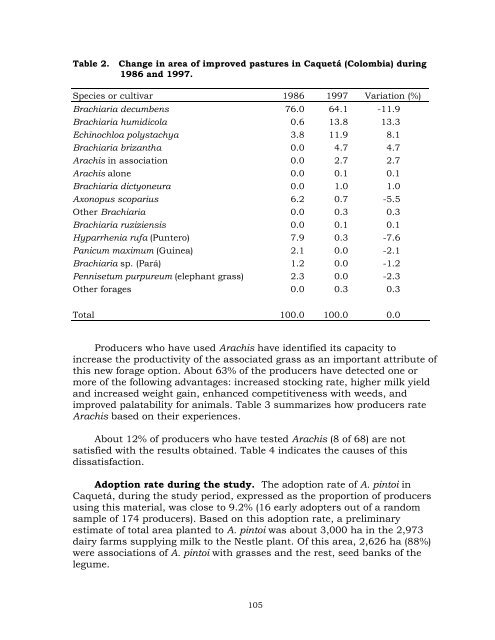Feeding Systems with Legumes to Intensify Dairy Farms - cgiar
Feeding Systems with Legumes to Intensify Dairy Farms - cgiar
Feeding Systems with Legumes to Intensify Dairy Farms - cgiar
You also want an ePaper? Increase the reach of your titles
YUMPU automatically turns print PDFs into web optimized ePapers that Google loves.
Table 2. Change in area of improved pastures in Caquetá (Colombia) during<br />
1986 and 1997.<br />
Species or cultivar 1986 1997 Variation (%)<br />
Brachiaria decumbens 76.0 64.1 -11.9<br />
Brachiaria humidicola 0.6 13.8 13.3<br />
Echinochloa polystachya 3.8 11.9 8.1<br />
Brachiaria brizantha 0.0 4.7 4.7<br />
Arachis in association 0.0 2.7 2.7<br />
Arachis alone 0.0 0.1 0.1<br />
Brachiaria dictyoneura 0.0 1.0 1.0<br />
Axonopus scoparius 6.2 0.7 -5.5<br />
Other Brachiaria 0.0 0.3 0.3<br />
Brachiaria ruziziensis 0.0 0.1 0.1<br />
Hyparrhenia rufa (Puntero) 7.9 0.3 -7.6<br />
Panicum maximum (Guinea) 2.1 0.0 -2.1<br />
Brachiaria sp. (Pará) 1.2 0.0 -1.2<br />
Pennisetum purpureum (elephant grass) 2.3 0.0 -2.3<br />
Other forages 0.0 0.3 0.3<br />
Total 100.0 100.0 0.0<br />
Producers who have used Arachis have identified its capacity <strong>to</strong><br />
increase the productivity of the associated grass as an important attribute of<br />
this new forage option. About 63% of the producers have detected one or<br />
more of the following advantages: increased s<strong>to</strong>cking rate, higher milk yield<br />
and increased weight gain, enhanced competitiveness <strong>with</strong> weeds, and<br />
improved palatability for animals. Table 3 summarizes how producers rate<br />
Arachis based on their experiences.<br />
About 12% of producers who have tested Arachis (8 of 68) are not<br />
satisfied <strong>with</strong> the results obtained. Table 4 indicates the causes of this<br />
dissatisfaction.<br />
Adoption rate during the study. The adoption rate of A. pin<strong>to</strong>i in<br />
Caquetá, during the study period, expressed as the proportion of producers<br />
using this material, was close <strong>to</strong> 9.2% (16 early adopters out of a random<br />
sample of 174 producers). Based on this adoption rate, a preliminary<br />
estimate of <strong>to</strong>tal area planted <strong>to</strong> A. pin<strong>to</strong>i was about 3,000 ha in the 2,973<br />
dairy farms supplying milk <strong>to</strong> the Nestle plant. Of this area, 2,626 ha (88%)<br />
were associations of A. pin<strong>to</strong>i <strong>with</strong> grasses and the rest, seed banks of the<br />
legume.<br />
105
















